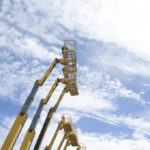Telehandlers are powerful machines that offer invaluable service to industries across the world, from construction and agriculture to logistics, mines and quarries. Yet these vehicles can pose a deadly hazard to workers. Emily Hardy, from vehicle safety experts Brigade Electronics UK, outlines the dangers and explains how technology can help protect against accident and injury.
The telehandler is a vital piece of equipment widely used by industries across the globe. Also known as telescopic handlers, cherry pickers or rough terrain forklifts, they operate as a cross between the crane and the forklift, with versatile attachments including winches, pallet forks, snow ploughs and buckets.
Whether transporting heavy pallets, shifting hay bales or scooping snow, telehandlers are in high demand, with around 70,000 units produced annually. About two thirds of this demand is concentrated in Europe and North America.
While the safety records of these vehicles is generally good, preventable accidents resulting in injury or death continue to be a serious issue. Risks of operating telehandlers include accidentally tipping a load, overbalancing the vehicle so that it tips laterally, and failing to see workers in the vicinity of the plant, particularly while reversing. When in operation with the boom raised, there’s also a significant danger of a blind spot to the front right-hand side of the vehicle.
In September 2019, a farmer in Powys was killed when the telehandler he was working in overturned and he became trapped. Another recent tragedy occurred when a waste and recycling worker died from multiple injuries after he was struck by a telehandler as it reversed at a yard in Horley, Surrey.
Accidents at work are distressing for all parties. While workplace safety is strictly governed in the UK and compliance levels are high, improvements can always be made. Safety technology is constantly evolving; many of the latest devices can be retro-fitted to vehicles, giving telehandler operators the best possible chance of maintaining a spotless safety record. Indeed, the Health and Safety Executive (HSE) recommends that telehandlers ‘should be equipped with adequate aids so drivers can see areas where people may be at risk.’
Safety camera systems
Retro-fitting vehicles with safety camera monitor systems, such as Brigade Electronics’ best-selling Backeye®360, allows drivers to keep a close eye on blind spots at the back and sides of their vehicle so they can instantly see other workers, vehicles, or members of the public in the vicinity.
This intelligent four-camera technology is designed to eliminate vehicle blind spots and assist manoeuvrability in challenging situations by providing the driver with a complete 360-degree view of their vehicle in a single image. The system combines images from four ultra-wide-angle cameras, providing a real-time view on the teleporter’s monitor. The result is a ‘bird’s-eye-view’ of the vehicle and surrounding area.
Radar Obstacle Detection
Radar obstacle detection technology can detect stationary and moving objects even in the harshest of environments. It gives the driver an audible and visible warning when objects are within a certain distance.
Heavy duty and able to operate even in high or low temperatures, radar obstacle detection is also waterproof and smoke resistant, and can be easily heard in noisy environments.
Mobile recording
When camera systems are linked to a mobile digital recording set-up (MDR), the recorded footage can provide irrefutable evidence in the event of a collision, or any kind of incident, such as vandalism or theft from a vehicle.
One major benefit of MDR is its ability to support drivers who can often be the subject of increased scrutiny after an incident. The latest MDR systems, such as Brigade’s, also have 3G and 4G connectivity, meaning that data can be live-streamed remotely with real time GPS tracking.
Smart Reversing Alarms
Warning alarms are audible devices to alert pedestrians and workers when a vehicle is manoeuvring. Unlike traditional ‘beep beep’ tonal alarms, which can be almost impossible to pinpoint, the latest technology creates a ‘ssh-ssh’ sound and uses smart technology to adjust sound levels in line with the ambient noise in the immediate vicinity. Utilising a wide range of frequencies, smart reversing alarms also enable the listener to instantly locate what direction the sound is coming from. In adverse conditions, for example if rain is pounding down, the warning decibel level will be increased.









